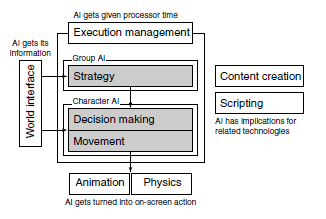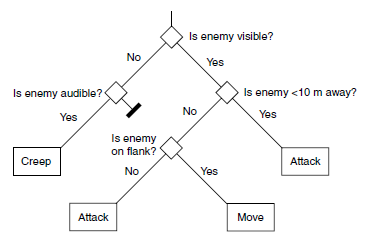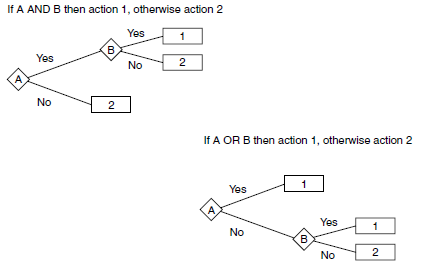Artificial Intelligence for Games
Millington, I & Funge, J
1.2 Model of Game AI

The AI Model provided within the book.
Model splits AI tasks into three groups; Decision Making, Movement, and Strategy.
Decision Making
& Movement contain algorithms
working on a per-character basis.
Strategy operates
on a whole team.
Board games (Chess,
Risk) only require Strategy
level.
Platform games (Jak
and Daxter, Oddworld) only require Decision
Making and Movement level.
1.2.1 Movement
If a character is attacking in melee, they will home in on
the player, only activating the attack animation at a certain range.
Movement can be
more complex; e.g. Splinter Cell, if
the player is seen by a guard, they may attempt to locate the closest
wall-mounted alarm, which can involve navigation over long distance.
1.2.2 Decision Making
“Involves a character working out what to do next.”
Will typically have a range of behaviours to choose from,
decision making system need to work out the most appropriate behaviour at the
given time.
Zelda games; farm
animals stand still, move a small distance if bumped into.
Half-Life 2; enemy
AI attempt multiple strategies to reach the player.
1.2.3 Strategy
Most action-based 3D games use only Decision Making and Movement.
“Strategy refers to an overall approach used by a group of
characters.” In context of the book.
Will often still require characters to have their own Decision Making and Movement, with Decision Making being influenced by the group Strategy.
1.2.4 Infrastructure
To build an AI, a whole set of additional infrastructure is
required.
Movement requests
must be turned into action in the game.
AI requires game information to make sensible decisions,
sometimes called “perception”; “working out what information the character
knows”.
“World Interfacing is often a large proportion of the work
done by an AI programmer”, and often the majority of AI debugging.
AI systems need to be managed to use the correct processor
time and memory.
1.2.5 Agent-Based AI
Focused on “producing autonomous characters that take in
information from the game data, determine what actions to take based on the
information, and carry out those actions.”
Can be seen as a bottom-up design:
- · Work out how each character will behave, and the AI required to support it
- · Overall behaviour of the game is a function of how character behaviours work together
- · Decision Making and Movement make up the AI for an in-game agent
Non-Agent-Based AI act oppositely, from top to bottom. E.g.
Pedestrians and traffic in Grand Theft
Auto 3. Traffic and pedestrian flow is calculated via the time of day and
the region of the city, and is only turned into singular cars and pedestrians
when in view of the player.
“A good AI developer will mix and match any reliable techniques that
get the job done, regardless of approach”.
1.3 Algorithms, Data Structures, and Representations
1.3.1 Algorithms
They are step-by-step processes, generating a solution to
problems faced by AI.
Data structures hold data that allow the algorithm to quickly
manipulate it and reach a result.
Data structures must often be tuned for one specific
algorithm.
Set of elements must be understood to implement and refine
an algorithm:
·
The problem that the algorithm tries to solve
·
A general description of how the solution works,
including diagrams where needed
·
Pseudo-code presentation of the algorithm
·
An indication of the data structures required to
support the algorithm, including pseudo-code where required
·
Particular implementation nodes
·
Analysis of algorithms performance: Execution
speed, memory footprint, scalability
·
Weaknesses in approach
5.2 Decision Trees
“Fast, easily implemented, and simple to understand.”
Simplest technique discussed in book, with the potential to
become quite sophisticated.
Very modular and easy to create.
5.2.1 The Problem
Using a set of knowledge, corresponding actions must be
generated from a set of possible actions.
Mapping between input and output can become complex.
Same action may be used for multiple inputs, but a change in
one input value can turn that action from sensible to stupid.
Require a method capable of easily grouping lots of input
together under one action, while allowing the significant input values to
control the output.
5.2.2 The Algorithm
Decision tree is made up of connecting points, starting at a
“root” decision, with ongoing options being chosen thereafter.

Example of a decision tree
Choices are made based on the characters knowledge, often
referring directly to the global game state, rather than a personal representation.
Algorithm continues along the tree until there are no more
decisions to consider. An action is attached to each leaf. Once a leaf is
reached, the relating action will be carried out.
Tree decisions will often be simple, with only two responses.
NOTE: Even just at this point, I feel a lot more confident
pushing into the AI, structuring a tree in my mind that will be put onto paper.
Though I have seen tree diagrams and flowcharts used in many ways previously,
it never occurred to me that it could be implemented into AI Decision Making.
Common for object-oriented engines to allow the tree to
access methods of instances.
To AND two decisions, they are placed in series in the tree;
“I A AND B, then carry out Action 1, otherwise carry out action 2.”
To OR two decisions, they are placed in the opposite series
in the tree; “If A OR B, then carry out Action 1, otherwise carry out action 2.”

An AND and OR tree
As decisions are built into the tree, the amount considered
will be much smaller than the amount within the tree.
Can be built in stages; simple tree can be initially
implemented, with additional decisions added on as needed.
Can be given more than two options to choose from;
Guard in a military facility, decisions based on current
alert status; green, yellow, red, or black. Using binary decisions, the alert
value must be checked three times. Using multiple branching, the value can be
checked once for the decision.
Implementation of multiple branches are not as easily
optimised as binary. Majority will always be binary.
Following on from this reading, I felt like I had a much clearer understanding of how to tackle my AI, and went about creating a simple decision tree for my AI:
Using this tree as a basis, I have gone on to pseudo-code the process:
While I believe there may be further tweaking required once implementing the code, the process of creating the decision tree, and writing some basic pseudo-code for the process, has greatly helped my learning process, and eased many concerns I had towards AI.
Tomorrow I shall begin implementation of the code, and hopefully have a level of working AI before the week is out.
Bibliography
Millington, I & Funge, J (2009). Artificial Intelligence for Games. 2nd ed. Burlington, MA: Morgan Kaufmann. p8-12, 295-300.
While I believe there may be further tweaking required once implementing the code, the process of creating the decision tree, and writing some basic pseudo-code for the process, has greatly helped my learning process, and eased many concerns I had towards AI.
Tomorrow I shall begin implementation of the code, and hopefully have a level of working AI before the week is out.
Bibliography
Millington, I & Funge, J (2009). Artificial Intelligence for Games. 2nd ed. Burlington, MA: Morgan Kaufmann. p8-12, 295-300.

No comments:
Post a Comment